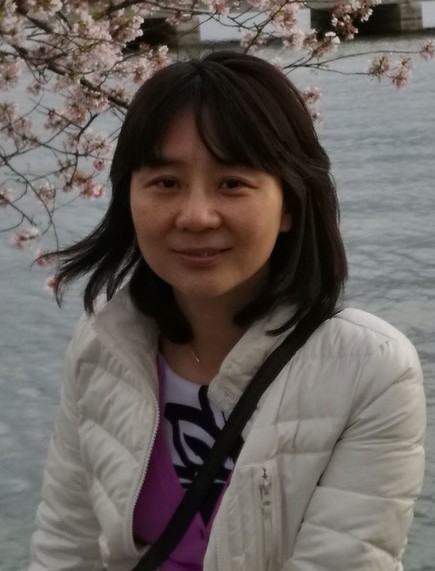Past Project Leaders
Dr. Kara Pratt
Associate Professor, Department of Zoology and Physiology
kpratt4@uwyo.edu | (307) 766-5589 | Biological Sciences 305 | Faculty page
The role of presenilin in a developing visual circuit
Project Summary:
To function properly, a neural circuit needs to be built properly. How a population of newborn neurons self-assembles into networks that receive, integrate, and transform external stimuli into an internal perception is a fundamental and important question in neuroscience. To address this question, we study molecular mechanisms underlying nervous system development. For this project we focus on the role of a single molecule, Presenilin (PS), an interesting molecule that was first identified, and named, in the context of Alzheimer’s disease, but is now known to carry out a myriad of functions that are important during development. A comprehensive understanding of the function of PS throughout normal nervous system development, however, is lacking, and providing such a comprehensive understanding is the goal of this project. For this, we study PS in the developing Xenopus tadpole retinotectal projection, a model system ideally suited for the study of a protein across all stages of neural circuit development, and at the cell, circuit, and behavioral levels, something not presently possible in mammalian systems. This stems from the fact that, unlike its mammalian counterparts, the development of this vertebrate is entirely external, from fertilization and onwards, allowing for access to all stages of development without disrupting, nor needing to attempt to mimic, the embryo’s natural environment. By using this particular model system to study a molecule which has many substrates and is associated with both neural development and neurodegeneration, this project promotes the identification of links between the way a circuit develops, and how it functions, or dysfunctions later in life. Determining how pathologies at the single cell level impact visual circuit function and visually guided behaviors will provide key fundamental concepts both for the visual system and potentially sensory circuits in general.
Dr. Jared Bushman
Assistant Professor of Pharmaceutical Science, School of Pharmacy
jbushman@uwyo.edu | (307) 766-4189 | Health Sciences 480
Delineating and Modulating the Gliotic Changes Occurring After Spinal Cord Injury
Project Summary:
Injury to the central nervous system (CNS) by disease or trauma causes a cascade of cellular responses that must occur to restore the delicate microenvironment necessary for function of the CNS. However, the changes caused to CNS tissue by these cellular responses may create an environment that is not permissive to functional regeneration. For patients, this results in permanent loss or aberration of function. In the case of spinal cord injury (SCI), patients often develop allodynia and other pain syndromes in addition to motor impairment. We are seeking to gain a better understanding of the cellular processes that occur following SCI that cause impairment and to develop therapies of small molecules and optogenetically responsive cells to promote functional repair of neural circuits.
We are specifically interested in the changes that occur in activated astrocytes and the alterations in the expression of glycans following SCI that occur during gliosis. We will develop a model of reactive astrogliosis using precursor derived astrocytes that can be used to delineate the signaling mechanisms responsible for astrogliosis. We hypothesize that extensive changes in glycosylation occur during astrogliosis that mediate the injury response after SCI and will test this by characterizing large scale changes in glycosylation after SCI. Glycomics is an advancing field and this would be the first study documenting the changes in glycosylation in the CNS after an injury.
Our second and third aims are more translational in nature and will develop therapeutics that both mitigate inhibitory signals after SCI and provide positive cues to stimulate regeneration. Chondroitin sulfate (ChS) is a glycan known to inhibit regeneration and we hypothesize that compounds can be identified that bind to and mask ChS from inhibitory receptors. To provide positive stimuli, we will develop and test an optogenetic system that we hypothesize can be used to control the behavior of cells (proliferation, gene expression etc) post-implantation by non-invasive means.
Dr. Baskaran "Baski" Thyagarajan
Associate Professor of Pharmaceutics and Neuroscience, School of Health Sciences
Baskaran.Thyagarajan@uwyo.edu | (307) 766-6147 | Health Sciences 279 | Baskilab webpage
Modulation of pain signaling mechanisms by Botulinum Neurotoxin A
Project Summary:
This proposal investigates the novel mechanisms by which botulinum neurotoxin A suppresses pain, by inhibiting the sensitization of TRPV1/TRPA1 channel proteins by PKC and advances the safe, site specific use of the neurotoxin to counteract pain without use dependence or addiction.
Dr. Yun Li
Assistant Professor, Department of Zoology and Physiology
yli30@uwyo.edu | (307) 766-4207 | Biological Sciences Building 414 |
In Vivo Calcium Imaging at the Frontal Cortex in Mouse Models of Brain Disorders
Project summary:
The overall objective of this proposal is using mouse models to examine the pathogenic mechanism by which loss of TAR DNA binding protein 43kDa (TDP-43) contributes to aberrant neural activity and, ultimately, neurodegeneration. TDP-43 predominantly functions as a nuclear protein important for transcription regulation. However, its cytosolic aggregates are commonly found in patients with neurodegenerative diseases including amyotrophic lateral sclerosis (ALS) and frontotemporal dementia (FTD). Since cytosolic accumulation of TDP-43 is usually accompanied by its nuclear clearance, a loss-of-function mechanism has been proposed to contribute to neurodegeneration. The underlying pathogenic pathways driven by the loss-of-function of TDP-43 are largely unknown.
Our preliminary in vivo calcium imaging studies demonstrated biphasic changes at population levels from pyramidal neurons of prefrontal cortex in spontaneously occurring calcium transients following TDP-43 depletion. We propose to study the pathogenic mechanisms of TDP-43 loss-of-function on two levels: Frist, we will repetitively measure from the same pyramidal neurons, the spontaneously occurring calcium transients over time, to elucidate phasic changes in neural calcium transients following TDP-43 depletion. Second, we will measure phasic changes in intrinsic excitability of pyramidal neurons elicited by TDP-43 depletion, to decipher the correlation between abnormalities in calcium transients and neural excitability. Completion of the proposed studies will determine how TDP-43 loss-of-function drives aberrant neural activity prior to neurodegeneration, whether hyperactivity and hypoactivity are mechanistically related, and which of the two is the primary driving force for pathogenesis. Filling these knowledge gaps will help to pave the new way towards early intervention for ALS and FTD.
Dr. William "Trey" Todd
Assistant Professor, Department of Zoology and Physiology
wtodd3@uwyo.edu | (307) 314-4207 | Biological Sciences 406
Project Title: Circadian behavior circuits, Alzheimer’s pathology, chemogenetic output and input
Project Summary:
Aim 1. To examine the relationship between circadian dysfunction of aggression propensity and LMA rhythms to immunohistochemical markers of AD-related neuropathology in the central SCN clock, the SPZ, and their output and input pathways. In tissue from TAPP mice and double WT controls, I will use immunohistochemistry to assess AD neuropathology (a-beta and tau) in the SCN, the SPZ and its major output targets, the VMH and DMH, as well as in regions known to project to the SCN and SPZ. I will also examine cell loss in these brain areas and in RGCs that project to and entrain the SCN. I will use brain tissue and retinas from male mice in which I previously examined aggression and LMA rhythms, and I will add an equal number of additional female mice that will also undergo LMA recordings and aggression tests.
Aim 2. To determine whether chemogenetic activation of the SPZ output pathway, and the RHT input pathway, reduces increased aggression and circadian sleep-wake dysfunction associated with ADrelated neuropathology. Using neural injections of a nonconditional, excitatory chemogenetic viral vector into male and female TAPP mice, I will activate SPZ neurons and RGCs via peripheral injection of the chemogenetic ligand, or its vehicle, at a time of day at which I have shown these cells to normally be active. I will then measure the effects of this phase-dependent neuronal activation on aggression using a resident intruder paradigm, and separately on sleep-wake rhythms using encephalographic (EEG) and electromyographic (EMG) recordings.
Dr. Karen Mruk
Assistant Professor, School of Pharmacy
kmruk@uwyo.edu | Health and Sciences Center |
Zebrafish Models of CNS Injury and Locomotor Recovery
Project Summary:
Approximately 290,000 Americans live with spinal cord injury (SCI) - a better understanding of the process of SCI and new therapeutic strategies are needed to tackle this significant problem. Regenerative species that can overcome the deleterious effects of SCI are a great resource to identify new therapeutic targets. The zebrafish shares many organizational, cellular and molecular pathways with mammals; however, regeneration and locomotor recovery occurs even after complete transection of the spinal cord. The Mruk lab’s long-term goal is to understand whether manipulation of endogenous electrical signals through either electrical stimulation or drug treatment will promote regeneration in otherwise regeneration-deficient cell types.
Dr. Adam C. Nelson
Assistant Professor, Zoology/Physiology
anelso74@uwyo.edu |Biological Sciences Bldg 200A |
Nelson Lab website: https://www.nelsonlabuwyoming.comDiscovering how genes, neural circuits, and sensory systems give rise to social relationships.
Dr. Ana Clara Bobadilla
Assistant Professor, WWAMI Medical Education Program
abobadil@uwyo.edu | Health Sciences Ctr |
Bobadilla Lab
The lab currently investigates the neurobiological mechanisms of relapse to drugs. Specifically, we characterize the specific ensembles of neurons built through reward experience that drive reward-seeking behavior. By establishing whether or not addictive drugs highjack the circuitry/ensembles coding for biological rewards, these findings aim to advance fundamental understanding of goal-directed behaviors and the disorders altering them.

